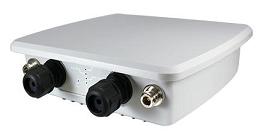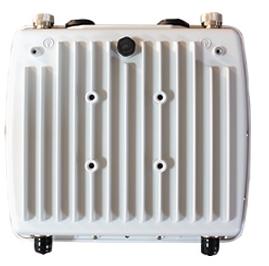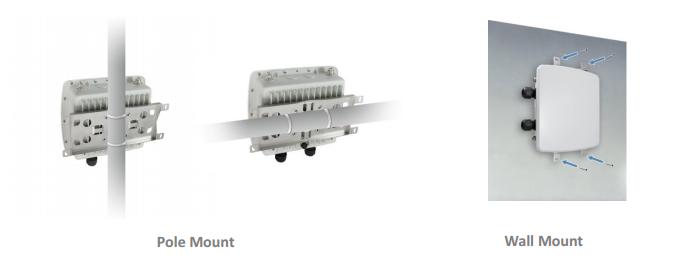


|
WLO-120AC
AC1200 Dual Band Concurrent Wireless Outdoor Bridge AP, W/ Captive Portal Hotspot Authentication & Centralized AP Management |
||||||||||||||||||||||||||||||||||||||||||||||||||

PheeNet WLO-120AC is an IEEE802.11ac 5GHz, and IEEE802.11n 2.4GHz Concurrent Dual Radio Wireless Outdoor Bridge / AP, which supports maximum throughput 1200Mbps, up to 300Mbps 2.4GHz and 867Mbps 5GHz, and providing the extra edge of increased flexibility & performance of WiFi deployment for enterprise, campus, WISP networks covering WiFi Access.
WLO-120AC has 1st radio 802.11n 2.4GHz 800mW (2 x Ntype connectors), and 2nd radio 802.11ac 5GHz 500mW (User must enter the software Web GUI to select either built-in 17dBi Dual Polarization Panel Antenna or 2 x Ntype connectors for External antenna). Depends on deployment demand, user can use both radio works as AP to provide WiFi service, or 1st Radio as AP and 2nd Radio as WDS mode/CPE mode, or any flexible combination). It concurrently addresses the growing needs of BYOD and bandwidth demands with no degradation in performance. WLO-120AC equips with heater with a smart temperature sensor which automatically turn on at -10 degree C to guarantee the stable and perfect operation during very low temperature environments. WLO-120AC with Rugged & Waterproof small size 2*Port IEEE802.3at/af Giga Ethernet POE can withstand a variety of extreme conditions – low & high temperatures, shocks & vibrations, dust particles or even liquid immersion. This is an easy way to make the Ethernet networks of your manufacturing site, automation or control units deterministic. .JPG) Interface: Interface: 1. 5GHz 2 x Ntype connector (Software Web GUI Selectable between 1. 2.4GHz 2 x Ntype connector 17dBi Built-in Antenna) 2. Right Side Ethernet is Giga IEEE802.3at POE IN (ETH1) 3. Left Side Ethernet is Giga POE Pass-Through (ETH2) 4. HW Reset Button (Small hole) near ETH1 Port 5. LED Panel (6 LED Lights) for Status Indictation  1. 4 Holes for Mounting Bracket 2. Automatically adjustable Vent design which comply with UL60950-22 Pole Mount and Wall Mount Installation: Using the provided mounting bracket, user can deploy WLO-120AC in a wide range of outdoor environments.  Software Features Highlights 1. Operation Mode: - AP Mode (including Authentication AP Mode (Customized Captive Portal and User Authentication), Pure AP Mode, and AP with WDS Mode) - Control Access Point Mode (Centralized AP Management) - Client Bridge + Repeater AP Mode - WISP/CPE + Repeater AP Mode - Router AP Mode 2. Each SSID supports 802.1q VLAN tag standards, supporting up to 4096 group VLAN Tag capability 3. QoS (Quality of Service) for bandwidth management and traffic prioritization and supports Total users’ or individual user’s Upload / Download Bandwidth Control Speed limits. Administrator can regulate the maximum Bandwidth Upload / Download speed limit of individual guest user. 4. Support total 16 Multiple ESSID per device (8 ESSID on 2.4GHz and 8 ESSID on 5GHz) 5. Support IEEE802.11f IAPP and IEEE802.11r and IEEE802.11k Fast Roaming 6. Support total 16 WDS Links (2.4GHz band WDS x 8 and 5GHz band WDS x 8) 7. Support Band Steering technology which detects dual-band capable clients, and directs these clients to the less saturated 5GHz network 8. Support Ping Watchdog function, which automatically monitoring device operations and reboots the device before a crash occur 9. Support Auto Reboot Setting, allow automatically reboot by Daily/weekly/Monthly 10. 5GHz Antenna Selection in software Web GUI of either: Built-in 17dBi Dual Polarization Panel Antenna or 2x2 External N-type Antenna connectors 11. Support Traffic Monitor and Graphical GUI status Interface for Network and Radio Overview Wireless Architecture / Operation Modes 1. CAP (Control Access Point) Mode – Controller-less Centralized AP Management ■ Auto discovery for managed APs ■ AP-Automatic configuration and provisioning in Batch AP Setup Section (Batch AP Setup Item: VLAN Setup, Authentication Profile, Gateway & DNS, Time Server, Management Setup, Wireless Basic Setup, Wireless Advanced Setup, VAP Setup, Upgrade Via TFTP Server, Upgrade Via HTTP URL, Delay Reboot, Reboot Now) ■ AP Group management –maintain a set of setting templates that simplify the task to assign the same setting to multiple APs, including Dynamic Channel Allocation, Maximum User Limitation, MAC Filter Control ■ Auto-Heal between AP to guarantee Wireless Coverage Quality ■ Graphic Display of Map by Group and indicate the AP place on the map ■ Central firmware Upgrade-Select multiple APs and upgrade their firmware at the same time by HTTP and TFTP ■ Managed AP Monitoring - Monitor APs for traffic and system information - Track the number of associated clients to the APs - Supports Location Map Management ■ Authentication Profile - Numbers of Authentication Profile: 9 - Authentication Profile setup includes A. Authentication Method: 1) Guest – Auto expired guest account (Login time in Minutes, Login type – One time or Multiple time, QoS (Upload/Download Bandwidth) 2) Local User 3) OAuth2.0 (Google, FaceBook, Line) 4) POP3/IMAP B. Captive Portal (Template and Multiple Language define for each column displayed in Captive Portal; Customized Login HTML file in order to add advertisement link) C. Multiple User Login Enable/Disable D. Login Timeout Timer E. SSL protected login portal page F. Wall-Garden, Privilege User List for each VLAN G. Bandwidth Control (Total User Upload/Download, Peer User Upload/Download) - Authentication Profile can be applied to AP centrally 2. Access Point Mode ■ Pure AP Mode ■ AP with WDS Mode ■ Authentication AP Mode: For each VLAN/VAP, administrator can define different Authentication policy: - Authentication Method: 1) Guest – Auto expired guest account (Login time in Minutes, Login type – One time or Multiple time, QoS (Upload/Download Bandwidth) 2) Local User 3) OAuth2.0 (Google, FaceBook, Line) 4) POP3/IMAP 5) Built-in 802.1x Radius Server for Radius Account - Captive Portal (Template and Multiple Language define for each column displayed in Captive Portal; Customized Login HTML file in order to add advertisement link) - Multiple User Login Enable/Disable - Login Timeout Timer - SSL protected login portal page - Wall-Garden, Privilege User List for each VLAN - Bandwidth Control (Total User Upload/Download, Peer User Upload/Download) 3. Client Bridge + Repeater AP Mode It can be used as a wireless client to receive wireless signal over last mile applications, helping WISPs deliver wireless broadband Internet service to new residential and business customers. In this mode, the wired/wireless clients of WLO-120AC are in the same subnet from Main Base Station. If 5GHz Radio work as Wireless Client Router, 2.4GHz is Repeater AP, and vice versa. 4. WISP / CPE + Repeater AP Mode Either 5GHz or 2.4GHz Radio can be used as a WISP client router to receive wireless signal over the last mile, helping WISPs deliver wireless broadband Internet service to new residential and business customers. In this mode, the WLO-120AC is a gateway with NAT functions. The wired/either 5GHz or 2.4GHz wireless clients of WLO-120AC are on the different subnet from Main Base Station. If 5GHz Radio work as Wireless Client Router, 2.4GHz is Repeater AP, and vice versa. 5. Router AP Mode Ethernet port on WLO-120AC is WAN, and WLO-120AC is a gateway with NAT functions. It’s Wireless Interface (2.4Ghz and 5GHz) accepts wireless clients connections from client devices, and the wireless clients of WLO-120AC are on the different subnet from Main Base Station. Router AP mode does not support User Authentication function. Wireless Feature ■ Both 2.4GHz and 5GHz Dual Band Concurrent Operation ■ Transmission Power Control: Level 1 - 9 ■ Channel Bandwidth Setting: 20MHz, 20/40MHz, 80MHz ■ HT TX/RX Stream Selection: 1 or 2 ■ Supports packet transmission time control through Slot Time and ACK Timeout interval control functions ■ Supports Beacon Interval and performance control DTIM Interval for client power efficiency Wireless Security ■ SSID Visibility support to display or hide ESSIDs, and VLAN assignment on ESSID ■ Support 802.1x authentication (EAP-MD5 / TLS / TTLs) ■ WEP 64 / 128bit EAP-TLS + Dynamic WEP, EAP-TTLS + Dynamic WEP, PEAP/ MS-PEAP + Dynamic WEP ■ Support security protocol IEE802.11i Preauth (PMKSA Cache) ■ WPA-PSK/TKIP, WPA-802.1x/TKIP, 802.11i WPA2-PSK/CCMP/AES 128/256bit, WPA2(802.1x/CCMP/AES 128/256bit), No. of registered Radius Servers: 1 ■ Setting for TKIP/ CCMP/ AES 128/256bit (ASCII 63 & HEX 64) key’s refreshing period ■ ESSID supports VLAN Tag function; each group can use different virtual ESSID tag for organized traffic ■ Access Control List (ACL) by MAC Address ■ Client Isolation and Client Connection Limitations Quality of Service ■ Download and Upload traffic control and support Traffic Analysis and Statistics ■ IEEE802.11e WMM ■ DiffServ/TOS, COS, IEEE802.1Q Tag VLAN priority control Networking & Management ■ Support IEEE802.1Q VLAN Tag ■ Support IEEE802.1d Spanning Tree Protocol ■ Router/WISP mode supports DHCP server function to automatically give IP address to end clients ■ Router/WISP mode support fixed IP for DHCP clients and PPPoE dial-up link to the WAN Wifi network ■ Router/WISP supports PPPoE Reconnect, conveniently connecting clients to the DHCP server ■ Support Proxy DNS, Dynamic DNS, and NTP client ■ Intuitive Web-Based management interface, Administrator Access: HTTP and HTTPS and support CLI access via Telnet and SSH ■ Support remote Firmware Upgrade via Web, Reset to Factory Default ■ Support SNMP v1/v2c/v3, MIBII; Also support SNMP Traps to a list of IP Address ■ Support Ping Watchdog to detect crashes after consecutive failed pings ■ Support System log Setup to remote server Status Monitoring ■ Status monitoring of on-line users and authentication users ■ Rea-Time Online Users Traffic Statistic Reporting and users connection status ■ Support Syslog for diagnosing and troubleshooting ■ User traffic history logging Hardware Features Highlights ■ 2.4GHz IEEE802.11bgn standard with maximum data rate of 300Mbps ■ 5GHz IEE802.11an/ac with maximum data rate of 867Mbps ■ 2.4GHz 800mW and 5GHz 500mW High Power Design ■ Built-in 5GHz 17dBi Dual Polarization Panel Antenna (H16, E16) ■ External 4 N-type connectors (2 for 2.4GHz 2T2R, 2 for 5GHz 2T2R and 5GHz antenna output selectable in Software Web GUI) ■ Support POE Pass Through function to allow power to be passed to subsequent 802.3af/at POE devices ■ Built-in Heater with temperature sensor ■ IP67 rated Waterproof proof Aluminum-alloy housing ■ Built-in Lightning Arrestor (15KV ESD) ■ Support Hardware chipset base Watch Time Dog, allowing the OS to reboot automatically before crash
|
|||||||||||||||||||||||||||||||||||||||||||||||||||